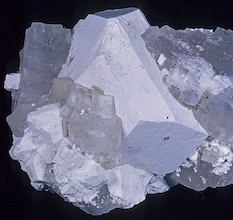 Despite its ubiquity, dark matter has eluded all attempts to detect it directly. Mara Johnson-Groh writes in Symmetry Magazine about a new “paleodetector” proposal to analyze ancient rock samples for traces of dark matter. She explains how even a tiny sample of a billion-year-old rock could carry a miniscule trail left over from the collision between an invisible dark-matter particle and a nucleus. Image: Halite, a mineral the scientists’ work suggests could be ideal for detecting traces of dark matter. By Rock Currier via Wikimedia Commons
Despite its ubiquity, dark matter has eluded all attempts to detect it directly. Mara Johnson-Groh writes in Symmetry Magazine about a new “paleodetector” proposal to analyze ancient rock samples for traces of dark matter. She explains how even a tiny sample of a billion-year-old rock could carry a miniscule trail left over from the collision between an invisible dark-matter particle and a nucleus. Image: Halite, a mineral the scientists’ work suggests could be ideal for detecting traces of dark matter. By Rock Currier via Wikimedia Commons
